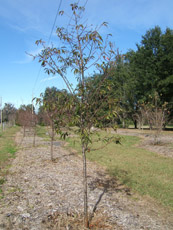Prunus x Okame (Okame Cherry)

*Click on picture for more images of this species.
- USDA Hardiness Zone: 6B - 9B
- Mature Height: 15 to 20 ft
- Mature Spread: 15 to 20 ft
- Growth Rate: Moderate
- Availability: Generally available
- Drought Tolerance: Low to moderate
- Salt Tolerance: Unknown
- Light Requirements: Full sun to partial shade.
- Native Origin: Not native to North America. Invasive potential not assessed.
- Soil Drainage: Needs a well-drained site.
- Foliage: Deciduous tree with showy fall color.
- Flowers: Pink, showy flowers in late winter.
- Pests: The main insect pests are canker worms, aphids, borers, scale, spider mites and tent caterpillars. No serious diseases.
Description: This hybrid of Prunus incisa and Prunus campanulata grows quickly when young and forms a 15 to 20-feet-tall and 20-feet-wide upright, oval silhouette. The dark green, 1 to 2.5-inch-long leaves cast medium shade beneath the tree, and turn lovely shades of yellow, orange, and red in the fall in the northern part of its range. In late winter to early spring, the trees are gaily decorated with a multitude of single pink blooms with red calyces and reddish flower stalks, making them quite outstanding in the awakening landscape. The trunk is wrapped with prominent lenticels raised above the smooth reddish-bronze bark.
Okame Cherry is one of the most delicate and finest flowering trees available and one of the best for the deep south since it apparently has a low chilling requirement. It has been seen flowering in January and early February well into Central Florida. Fall color is not showy in the southern part of its range but shows off nicely in the North. To produce a nice specimen tree, prune to thin out the canopy and open it up to allow for light to penetrate to interior foliage. Remove upright oriented branches in favor of those with a wider angle with the trunk to form a pleasing, spreading habit. A more upright shape can be created by removing lateral branches. Remove interior branches and space main branches along the trunk.
Use the tree along an entrance road to a commercial development planted on 20-foot centers or along side the patio or deck in the back yard. It also makes a nice small-scale court yard tree or specimen planted in the lawn or in bed of ground cover. It could be planted along a residential street where there is plenty of soil for root expansion. Okame Cherry can be grown in full sun in clay, loam or sandy soil but benefits from irrigation in dry weather. The tree benefits from some afternoon shade in the southern part of its range.
North Central Florida Observations: Our trees were planted from containers and unfortunately were planted very deep in the container and had many root defects as a result. These were hard to correct. Trees are struggling due to poor root systems. Okame Cherry I have planted in Gainesville in the past have done very well and should prove well adapted to the region. They can be planted in places were trees are needed near power lines.
Fact Sheet (pdf)
Click here for more photos of this tree.

